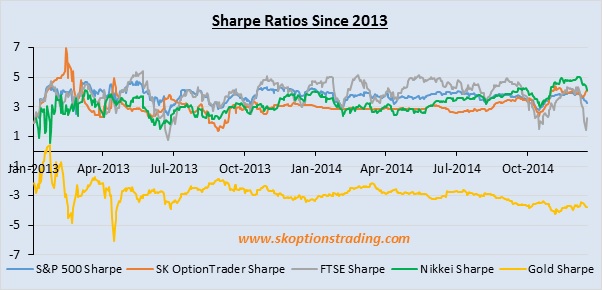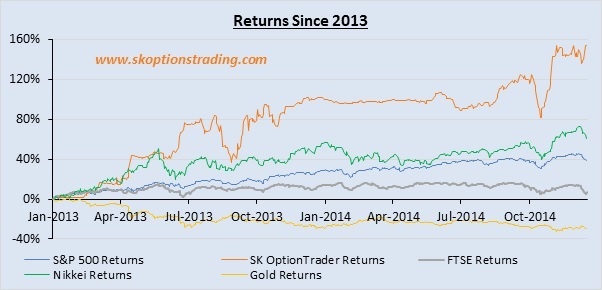|
Many investors use strategies that target the greatest possible returns
from their trades. However in doing so they often forget or misjudge the
risks that they are taking in order to earn those returns. The result of this
is that these traders are vulnerable to far greater losses than they expected
when first opening the position.
To be clear, we are not here to discuss why traders open positions that
lose money. Everyone will make incorrect calls on the market from time to
time, which is simply due to human nature. Instead we will address what “bad”
and “good” trades are and why they are often made, how to avoid making poor
trading decisions, and a measure of how a portfolio or strategy performs
relative to the risks taken.
Defining good and bad trades
Trivially, one may say that a bad trade is one that loses money and that a
good trade is one that turns a profit. However, this would be dismissing the
phenomenon of luck. One may have a trading strategy that is 90% likely to
return 5% each month, but has a 10% chance of losing 100% in any given month.
In this case, if they are initially lucky, one may believe their trading
strategy is sound and that they are making good trades. Then, when that luck
runs out, they may be wiped in a single month.
In this example, each month the trade has an expected portfolio change of
90% x 5% - 10% x 100% = -5.5%. This means that by using such a strategy one
should expect to lose 5.5% each month, even though one is 90% likely to make
a profit. Accordingly, trades that make money regularly are not necessarily
good ones. The converse is also true for strategies that often lose money, as
the size of the unlikely returns far outweigh the losses. This is a concept
often misunderstood by those in markets and is a reason that many investors
lose money, particularly if they are only targeting returns.
Thus, what makes a trade good or bad? The answer to this lies with the
risk reward dynamics of a trade. These are how the likelihood and size of the
potential losses compare to the potential profits. Once these have been
analysed then one can say that the risk reward dynamics are favourable or
that the trade is good, if the expected gains are greater than the expected
losses. This means that on average one would make money using the strategy or
particular trade. Similarly, a bad trade or strategy is one that has
unfavourable risk reward dynamics and that one would expect to lose money on
average if they used it.
Why do investors still make bad trades?
If this seems logical, then one may ask the question why someone would
open or continue to hold a bad trade. The arithmetic involved hardly requires
great mathematical skill after all. But, there are many reasons why seemingly
clever people and historically good investors make bad trades. A common
reason for losing money on a bad trade is a refusal to change ones view when
market dynamics clearly indicate that one’s view is wrong.
Let’s say that one believes that the S&P is going to rally new highs
and that a long trade has positive risk reward dynamics upon opening. Then,
sometime after the position is opened the market begins to fall rapidly. Many
do not plan for their trades performing poorly even if they believe they have
assessed the risk reward dynamics involved at the outset. This generally
leads to the view of “it can’t fall any further”, and the even more dangerous
thought that follows of “I should add buy again while it’s so cheap”. This
represents a misunderstanding of risk reward dynamics. They are not constant.
They are always changing and one needs to be aware of how.
This means one has to expand their pre-trade view to include parameters
that show that an initial market view is no longer correct. If one says that
market cannot fall 15% and it does, then one’s view was wrong and they should
cut their losses. Yet, many refuse to do this and cite many reasons as to why
the market is wrong instead. Markets are never wrong. If the pre-determined
parameters are reached, then the risk reward dynamics of the trade are no
longer favourable because the initial market view was incorrect.
Risk reward dynamics also change without disproving a market view. For
example, if one buys calls with the view that equities will rally, then
equities can rally without those calls becoming more valuable. The theta, or
time premium, costs can mean that the potential profits are eroded and the
risk reward dynamics eventually become negative. Or the rally that one
expected may have exhausted itself and it is simply time to take profits. The
risk reward dynamics of a trade that is in profit may become unfavourable
simply because all the money that could have been made has been.
Therefore, it can be very easy for an investor to be holding a bad trade.
However, why would they make one in the first place? The answer here comes
down to human nature. One could assess risk reward dynamics fully, set
parameters that would define if a trade becomes unfavourable, and even have a
market view that will be proven correct in time, yet they can still open a
bad trade.
Out of greed or boredom or for the sake of feeling busy one may make a
trade even when it goes against all of the logic and reasoning that we have
discussed. We are happy to say that we have never made such a trade. We have
never traded for trading’s sake and are content to remain on the side-lines
if we do not see a trading opportunity.
How to avoid poor trading decisions?
This is not a question of avoiding losses altogether, but limiting their
frequency and magnitude. To do this one must have discipline when trading. Our
own analysis of market fundamentals, technical indicators, seasonal effects,
and may other factors has meant that at times we go through periods without a
position open at all. During this time no position is in fact the best trade
one can make, one does not have to be in to win.
These periods can be frustrating for both ourselves and our subscribers as
they would be for any investor. However, we have avoided large losses and
have had capital available for future opportunities by not trading during the
periods that we could not ensure favourable risk reward dynamics. Through
this we avoid making trades that we expect to lose money. Of course one could
always take a punt and risk it, after all, they might get lucky. We do not
take such bets, we do not play dice, we make trades that we believe will be
profitable with positive risk-reward dynamics and nothing else.
Measuring risk reward dynamics
Prior to the opening of a trade how favourable or unfavourable a potential
position is will be based on one’s own views, which can be formed in many
different ways. This means that there is no unbiased way to judge the risk
reward dynamics of a trade before it is made. However, it is possible to
calculate how the returns compared to risks while a trade or strategy was active,
including on positions that are still open.
To do this we will use the Sharpe ratio. This measure quantitatively
assesses risk reward dynamics by comparing the returns above the risk free
rate to the volatility of the trade that made those returns. In reality there
is no asset that provides risk free returns, so we will use the 91 day
Treasury bill rate as our benchmark here as the lowest risk return. By taking
the difference between the returns of a particular portfolio and this rate,
we have the excess returns gained. To measure volatility we will use the
standard deviation of the daily change of that portfolio, which measures how
much daily returns vary from the average.
The chart below shows the Sharpe ratios of SK OptionTrader against various
stock indexes and gold. As stocks have been in a bull market volatility has
been contained and returns have been steady, which has produced high Sharpe
ratios for each. The atrocious performance in gold shows that the risk reward
dynamics of being long the yellow metal have been unfavourable for a
considerable amount of time.
 
The Sharpe ratios above indicate that the risk reward dynamics of
following the SK OptionTrader trading signals is roughly the same as those of
the major stock indexes. This may seem unimpressive when considered alone,
but then consider the returns on a mark to market basis shown below.
 
This shows that our risk management methods not only ensure positive risk
reward dynamics, but also provide phenomenal returns in the process. Our
portfolio has outstripped the Nikkei by more than double, the S&P 500 by
a factor of four, and the FTSE more than 30 times. We would also point out
that these returns are relatively uncorrelated. Only the Ebola outbreak
caused a significant pullback in both stocks and our portfolio, from which we
more than recovered.
Conclusion
Prudent risk management is key to trading. Without it one risks losing
more than they ever anticipated or, in the worst cases, more than they could
afford. Through careful market analysis, trading discipline, and ongoing
assessment of the risk reward dynamics of both open and future potential
trades it is possible to achieve sensible management of the risks involved in
trading while still generating phenomenal returns. We are the proof of this,
it has been more than two years since SK OptionTrader has closed a trade for
a loss and our portfolio is up more than 150% in that time.
These returns have been made on our part in two ways. The first is that
our analysis of the risks involved in trading that has meant we have avoided
taking heavy losses that would have wiped out our gains. The second is that
our trading results are exceptionally strong. Since its inception in 2009,
our model portfolio is up 994.38% and more than 90% of the trades we have
closed have been at a profit.
Regardless of whether you agree with our market views covered beyond this
article, you must agree that targeting returns alone is a poor way to trade.
If one lacks a full understanding of the risk reward dynamics at play in the
market and the trading discipline to utilise them, they stand to lose money
in the long run. At SK Options Trading we endeavour to avoid losing money if
it is avoidable, with discipline and risk reward the key focus, and we
believe that our trading record speaks for
whether we have achieved this. If you would like to find out exactly how we
apply these methods when trading and what positions we open, then you can
sign up via either of the buttons below.
Subscribe for 6 months- $499
Subscribe for 12 months- $799
|
